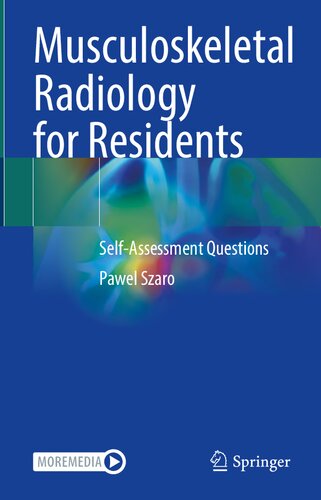رادیولوژی اسکلتی عضلانی دستیاران: سوالات خودارزیابی ۲۰۲۲
Musculoskeletal Radiology for Residents: Self-Assessment Questions 2022
دانلود کتاب رادیولوژی اسکلتی عضلانی دستیاران: سوالات خودارزیابی ۲۰۲۲ (Musculoskeletal Radiology for Residents: Self-Assessment Questions 2022) با لینک مستقیم و فرمت pdf (پی دی اف)
| نویسنده |
Pawel Szaro |
|---|
| تعداد صفحهها |
11 |
|---|---|
| نوع فایل |
|
| حجم |
15 Mb |
| سال انتشار |
2022 |
89,000 تومان
معرفی کتاب رادیولوژی اسکلتی عضلانی دستیاران: سوالات خودارزیابی ۲۰۲۲
این کتاب به ساکنین و رادیولوژیست ها اجازه می دهد تا دانش را در مورد رادیولوژی جنبشی ارزیابی کنند. بیشتر سؤالات کتاب، که از تجربه نویسنده در تدریس در بخش رادیولوژی در بیمارستان دانشگاه Sahlgrenska در گوتنبرگ، سوئد ناشی می شود، بسیار کاربردی و اغلب بر اساس تشخیص افتراقی است که در رادیولوژی اسکلتی عضلانی حیاتی است. یادگیری مبتنی بر مشکل در یادگیری عمیق مفید است و به درک بهتر فرآیندهای پاتولوژیک در استخوان ها، مفاصل، تاندون ها و ماهیچه ها کمک می کند. سوالات بر روی مسائل بالینی که در طول معاینات رادیولوژیکی با آن مواجه می شوند مانند MRI (جذاب ترین و سخت ترین برای دستیاران)، سی تی اسکن، سونوگرافی یا اشعه ایکس تمرکز دارند و برای تحریک ارزیابی روزانه معاینات در نظر گرفته شده اند.
این کتاب که با ویدئوها به عنوان مواد تکمیلی الکترونیکی غنی شده است، برای پزشکانی نوشته شده است که معاینات رادیولوژی حرکتی را ارزیابی می کنند. اطلاعات کتاب به روز و منطبق با نتایج تحقیقات علمی جاری است که در زیر پاسخ هر سوال به صورت خلاصه ای مختصر می توان آن را یافت.
پیشنهاد فعلی شکافی را در ادبیات رادیولوژی در خود ارزیابی جامع رادیولوژی اسکلتی عضلانی پر می کند و ممکن است توسط ساکنان و متخصصان جوان مورد استفاده قرار گیرد.
This book allows residents and specialists in radiology to assess knowledge about musculoskeletal radiology. Most of the book's questions, stemming from the author’s experience of teaching residents in radiology at Sahlgrenska University Hospital in Gothenburg, Sweden, are very practical and often based on differential diagnosis, which is crucial in musculoskeletal radiology. Problem-based learning is useful in deep learning and allows a better understanding of pathological processes in the bones, joints, tendons, and muscles. The questions focus on clinical problems encountered during radiological examinations like MRI (the most fascinating and difficult one for residents), CT, ultrasound, or x-rays, and are intended to stimulate the daily evaluation of examinations.
The book, enriched by videos as electronic supplementary material, is written for practitioners who evaluate examinations in musculoskeletal radiology. The information contained in the book is up-to-date and consistent with the results of the current scientific researches, which can be found under the answer to each question in the form of a concise summary.
The current proposal will fill a gap in the radiological literature in comprehensive self-assessment of musculoskeletal radiology and can be used by residents and young specialists.



